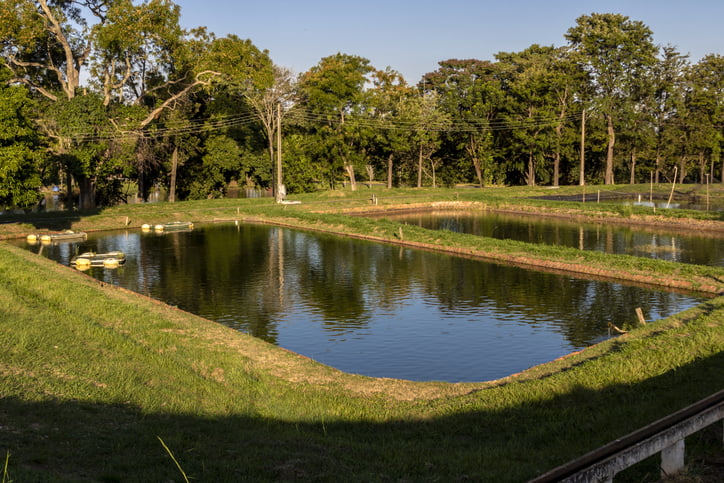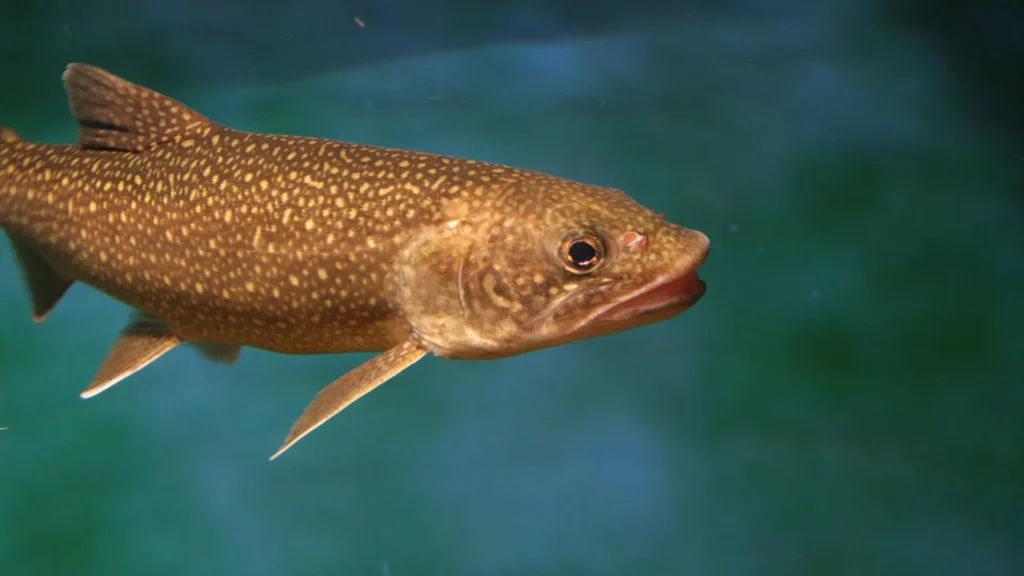Catfish ponds offer both economic and recreational value, making them a popular choice among pond owners. These ponds provide a low-maintenance option with high yield potential, especially when compared to other fish species. Not only do catfish ponds contribute to the local economy, but they also offer a tranquil and accessible fishing experience for anglers and families alike.
Considering a catfish pond? You’re in the right place. We’ll explore the benefits of pond ownership and provide valuable insights on building one. Let’s get started!
What is a Catfish Pond?
A catfish pond is specifically built for raising and cultivating catfish, providing controlled conditions for their growth and survival. Ponds can be constructed using techniques like earthen or concrete structures, with specific depth, size, and shape.
The pond depth must accommodate the catfish’s bottom-dwelling behavior, which varies from a few feet to several meters. Pond size is important for productivity, with larger ponds allowing for more catfish growth and higher populations.
Smaller ponds can still be effective for small-scale or recreational use. It is crucial to maintain optimal water quality. This is done by regularly monitoring and maintaining oxygen levels, temperature, pH, and water circulation.
Benefits of Owning a Catfish Pond
Catfish ponds are crucial for biodiversity and water quality. They create micro-ecosystems, supporting diverse fish species and aquatic life. These balanced ecosystems contribute to water health and natural resources, attracting organisms like crayfish and minnows to enhance biodiversity.
Catfish ponds offer environmental benefits and the potential for commercial success. With strategic management and harvesting, you can create a profitable catfish farming operation. The demand for catfish, particularly channel catfish, is high due to their tasty meat. Whether you sell them locally or to restaurants and fish markets, a well-maintained catfish pond presents undeniable income opportunities.
A catfish pond offers more than just financial value; it brings peace and a connection to nature. Observing the fish and water movement provides a calming experience, allowing us to unwind and disconnect from daily stress. Moreover, owning a catfish pond presents an opportunity to teach about sustainability and environmental awareness.
By responsibly managing the pond, you can educate others about preserving natural resources and maintaining a healthy ecosystem. This hands-on stewardship inspires a greater appreciation for nature’s delicate balance and the importance of conservation.
How to Build a Catfish Pond?
Constructing a catfish pond for farming is similar to building any other pond, but specific considerations like measurements and fish population are important. Studies and experts suggest that managing ponds between 8 to 10 acres is easier than larger ones. A depth of approximately 6 feet can conserve water and prolong fish lifespan.
Step 1: Plan And Choose Your Site
Choose the right location for your catfish pond, considering accessibility to water, sunlight exposure, and good drainage. A healthy environment is crucial for their success.
Step 2: Excavation And Shaping
Excavate the pond according to your desired size and depth, with 6-8 feet being optimal for catfish. Shape it with a gentle slope from the edges to the center for efficient management and erosion prevention.
Step 3: Preparing The Soil
To prepare the catfish pond bed, clear away rocks, roots, and debris, ensuring a smooth and compact surface for long-term stability. Proper soil preparation is crucial for establishing a strong foundation.
Step 4: Bentonite Application And Dosage
Buy sodium bentonite of good quality. Determine the quantity needed based on your pond’s surface area and desired sealing layer thickness. Follow the manufacturer’s guidelines for the correct dosage. Combine the bentonite powder with water to create a slurry-like mixture, resembling pancake batter.
Step 5: Applying The Bentonite Slurry
To seal the catfish pond, start by evenly spreading a thin layer of bentonite slurry on the surface. Continue applying the slurry in layers until it reaches the desired thickness (1/8 to 1/4 inch). It is crucial to take your time and pay attention to detail during this step for successful sealing.
Step 6: Compaction And Curing
Compact the surface after applying bentonite for better clay-soil contact. Let the bentonite cure for a few days while keeping it moist. Watch as it swells, forming a waterproof seal to support healthy catfish growth.
Step 7: Add Water
After curing, add water from a reliable source to fill the pond. Monitor closely for leaks to ensure the effective seal. Your catfish pond is now a reality!
Pond Management for Catfish
When managing a catfish pond, prioritize water quality management. Balance pH levels and ensure adequate oxygenation. Add aerators or diffusers for oxygen circulation and regularly test pH within the ideal range of 6.5 to 8.0.
Choose the appropriate catfish species carefully. While channel catfish are popular and versatile, consider other options. Blue catfish and flathead catfish provide the excitement of catching larger fish. Understand the traits and needs of different catfish species to make informed choices that fit your objectives and pond conditions.
Proper vegetation and predator management are crucial for a balanced catfish pond ecosystem. Excess vegetation depletes oxygen and promotes pests, so regularly controlling or removing it is essential. Tactics like netting, deterrents, or stocking predator fish effectively reduce risks from birds, turtles, and other fish.
To manage a catfish pond effectively, prevention and health monitoring are key. Regular checks and behavior observation detect disease or stress early on. Quarantining new fish prevents disease spread. Maintaining catfish health and growth requires a well-balanced diet with high-quality feed.
Catfish Feeding and Nutrition
Catfish feeding habits and preferences are crucial for their optimal growth. These fish are known for being bottom feeders, which means they primarily scavenge for food near the pond bottom. They use their barbels, sensory organs located near their mouth, to locate and consume their prey. Catfish have a strong appetite and eat various food sources like insects, worms, crustaceans, and smaller fish.
When it comes to feeding catfish, it is important to consider both the frequency and quantity of feed. Catfish thrive when they are fed multiple times throughout the day, rather than with just a single large feeding. This allows them to consume smaller portions of food, which they can digest efficiently. Feeding catfish 2-3 times daily, in controlled amounts, supports their health and growth.
Catfish owners have various options for feeding their fish, including both artificial and natural feed sources. Artificial catfish feeds are widely available and can provide the necessary nutrients for their growth. Catfish pond feeds are specially formulated with a balanced blend of proteins, fats, and carbohydrates to meet their nutritional needs. Choosing a feed specifically designed for catfish is crucial, as their dietary requirements differ from other fish species.
Additionally, natural feed sources can be incorporated into a catfish’s diet for added variety and nutrition. This can include live or frozen food such as worms, insects, and small crustaceans. Utilizing these natural feed sources can help stimulate the catfish’s natural feeding instincts and promote their overall health.
To ensure optimal growth and overall health, catfish also require supplementary nutrients and vitamins. Some catfish feeds already contain these essential elements, but supplementation may be necessary in certain cases. Supplementing with fish oils or specialized nutrients promotes catfish growth, immune system development, and well-being.

Conclusion:
Building a catfish pond is an enriching endeavor for beginners. This guide covers essential steps from selecting a location and digging the pond to stocking it with catfish and maintaining water conditions. Understanding ecosystem dynamics, filtration systems, and feeding schedules are pivotal for success. Patience and attention to detail are invaluable.
What are your thoughts on the topic? Feel free to leave a comment below!
FAQS:
What type of pond is best for catfish?
Embankment ponds are the ideal choice for large-scale catfish farming due to their ability to be constructed in extensive, uninterrupted areas. This not only facilitates efficient pond management but also offers several other advantages.
2. How long does it take to raise catfish in a pond?
Catfish of six to eight inches have the potential to reach a weight of one pound within a span of six months. However, in the absence of consistent feeding, it can take two to three years for them to attain the same size.
What do catfish need to survive in a pond?
Young catfish have a diverse diet including insects, snails, crawfish, algae, plants, seeds, and small fish. They are adaptable and can also be fed commercial pellets. Maintaining a warm-water temperature of 85 degrees Fahrenheit is crucial for their optimal growth. Good water conditions are vital for the health and development of catfish.
How many catfish can I put in a 5 acre pond?
To promote a thriving catfish population in your pond, it’s best to stock at 50 catfish per acre. This encourages growth, reproduction, and improves overall pond health, attracting anglers seeking a rewarding fishing experience. Maintaining this stocking rate ensures an ideal environment while supporting long-term population.
Will catfish eat my other fish?
Catfish have diverse feeding habits, consuming a range of food sources, including other fish. Various species of catfish have distinct feeding strategies, actively pursuing and consuming smaller fish or opportunistically preying on their surroundings.
Additional Resources:
- Catfish in the backyard pond: https://fullserviceaquatics.com/catfish-in-your-backyard-pond-friend-or-foe/
- How to build a large fish pond?: https://www.quora.com/How-do-I-build-a-large-fish-pond
- How to make backyard fish pond: https://www.wikihow.com/Make-a-Backyard-Fish-Pond
- How to build a low maintenance pond: https://www.familyhandyman.com/article/pond-how-to-build-a-low-maintenance-pond/
How to start your catfish farm in an existing farm pond: https://smallbusiness.chron.com/start-catfish-farm-existing-farm-pond-43443.html


